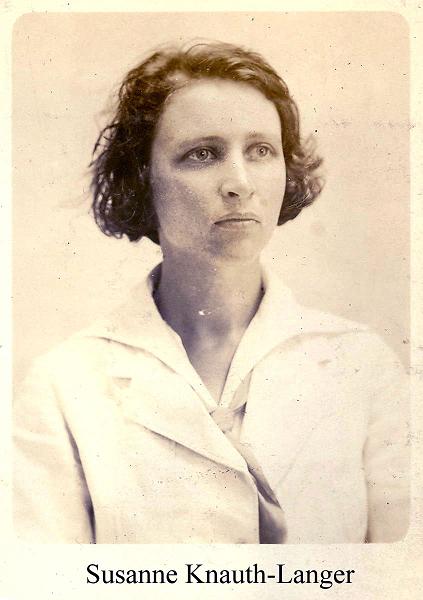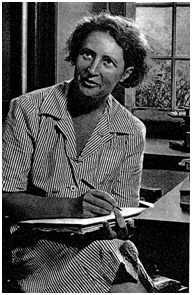<Back to Index>
- Philosopher Susanne Katherina Langer, 1895
- Painter Pieter de Hooch, 1629
- Foreign Minister of France Charles Gravier, comte de Vergennes, 1717
PAGE SPONSOR


Susanne Katherina Langer (née Knauth) (1895 - 1985) was an American philosopher of mind and of art who was influenced by Ernst Cassirer and Alfred North Whitehead. She was one of the first women to achieve an academic career in philosophy and the first to be popularly and professionally recognized as an American philosopher. Langer is best known for her 1942 book Philosophy in a New Key.
Langer was born in Manhattan, the daughter of German immigrants Antonio Knauth, a lawyer, and Else M. (Uhlich) Knauth. German was spoken exclusively at home and she never completely lost her accent. As a girl, Langer learned to play both the cello and piano and for her early education attended Veltin private school. She studied at Radcliffe College, receiving her bachelors degree in 1920, and her doctorate in 1926. Alfred North Whitehead was her dissertation adviser. She taught at Radcliffe, Wellesley College, Smith College, and Columbia University and was visiting lecturer at a number of other institutions. In 1941 she met Ernst Cassirer whose work The Philosophy of Symbolic Forms she had read in the 1920s and had greatly influenced her thinking. Recognizing their common ground, Cassirer remained in close contact with Langer until his death in 1945.
In 1921 she married William L. Langer who later became a history professor at Harvard. They had two sons, Leonard, born in 1922, and Bertrand, born in 1925. In the late 1930's they drifted apart and were divorced in 1942.
From 1952 to 1962, Langer was professor of philosophy at Connecticut College. She was elected to the American Academy of Arts and Sciences in 1960. In 1956 she was awarded a grant from the Edgar J. Kaufmann Foundation which allowed her to devote the remaining 25 years of her life to research and writing.
Langer died in Old Lyme, Connecticut, on July 17, 1985 after finishing the third volume of her magnum opus, Mind: An Essay on Human Feeling. Langer's
philosophy explored the human mind's continuous process of
meaning-making through the power of “seeing” one thing in terms of
another. Langer's first major work, Philosophy in a New Key put
forth an idea that has become commonplace today: that there is a basic
and pervasive human need to symbolize, to invent meanings, and to
invest meanings in one’s world. Beginning with a critique of positivism, the work is a study of human thought progressing from semantic theory through philosophy of music sketching
a theory for all the arts. For Langer, the human mind “is constantly
carrying on a process of symbolic transformation of the experiential
data that come to it,” causing it to be “a veritable fountain of more
or less spontaneous ideas”. Langer's distinction between discursive versus presentational symbols is one of her better known concepts. Discursive
symbolization arranges elements (not always words) with stable and
context invariant meanings into a new meaning. Presentation
symbolization operates independently of elements with fixed and stable
meanings. The presentation cannot be comprehended by progressively
building up an understanding of its parts in isolation. It must be
understood as a whole. For example, an element used in one painting may
be used to articulate an entirely different meaning in another. The
same principle applies to a note in a musical arrangement - such
elements independently have no fixed meaning except in the context of
their entire presentation. Langer believed symbolism is the central concern of philosophy because it underlies all human knowing and understanding. As with Ernst Cassirer,
Langer believed that what distinguishes man from animal is the capacity
for using symbols. While all animal life is dominated by feeling, human
feeling is mediated by conceptions, symbols and language. Animals
respond to signs, but humans' stimulus from a sign is significantly
more complex. The perspective is also associated with symbolic communication where animal societies are studied to help understand how symbolic
communication affects the conduct of members of a cooperating group. In
her later years, Langer came to believe that the decisive task of her
work was to construct a science and psychology based theory of the
"life of the mind" using process philosophy conventions. Langer's final work, Mind: An Essay on Human Feeling represents the culmination of her attempt to establish a philosophical and
scientific underpinning of aesthetic experience, relying on a three
volume survey of a comprehensive set of relevant humanistic and
scientific texts.